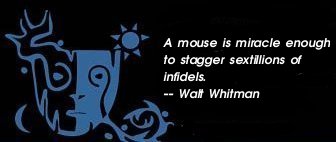|

Our Mythical Planet
by William G. Doty
Readers familiar with several of my earlier columns will not be shocked to learn that I am once again writing in advance of offering a new seminar. That on the horizon for this spring will map some aspects of the mythological attitudes toward the place/space where we dwell. We don't do that in monochrome, and the seminar will likewise mutate across a spectrum that includes deep ecology, feminism and goddess materials, cosmogony and cosmology (including Calvino's delightful Cosmicomics and George Crumb's comics from the 70s).
There will be trenches into ancient Mesopotamia (Gilgamesh) and the Maya Popol Vuh, as well as poetry from Walt Whitman and Gary Snyder, and origin/emergence/creation myths from several cultures that set out social roles and perspectives on gender and "nature." And the concepts of "wilderness" and "frontier" that ideologically drive land-use (and hopefully land-care).
 How do we imagine the planet, having seen it from the surface of the moon (the so-called "Blue Marble" portrait)? Is it more or less "personal" than it/she/he was for Hesiod or Homer or Zarathustra? When we've (some of us elders) seen a swastika, a symbol of health/wholth/sun-energy reaching back thousands of years in antiquity, get commandeered by a horrific Reich, how can I regard Navajo weavings from the early twentieth century that feature rows of them, some turning to the left, others to the right — as also on a Girl Scout camp pin made by one of my father's sisters? (Near my home town in New Mexico, there was even—pre-War—a Swastika Coal Mine.) How do we imagine the planet, having seen it from the surface of the moon (the so-called "Blue Marble" portrait)? Is it more or less "personal" than it/she/he was for Hesiod or Homer or Zarathustra? When we've (some of us elders) seen a swastika, a symbol of health/wholth/sun-energy reaching back thousands of years in antiquity, get commandeered by a horrific Reich, how can I regard Navajo weavings from the early twentieth century that feature rows of them, some turning to the left, others to the right — as also on a Girl Scout camp pin made by one of my father's sisters? (Near my home town in New Mexico, there was even—pre-War—a Swastika Coal Mine.)
Just where is the center of the earth, when each culture claims this or that primal mountain as the axis mundi, and has its own world-tree/cross? How is a sacred place identified? A point of creation or resurrection or epiphany of wisdom?
Do speculative-fiction visions count? Just think of all the views of Terra imaged from futuristic vessels plying between the stars! But already in Romanticism and Gothic novels, the planet became variously sublime — either glorious or threatening. Previously, as a college World Lit professor taught me over fifty years ago, a mountain was just an obstacle to be surmounted.
So we need to look at deserts and caves, labyrinths and oceans, chaos monsters and ley-lines. And myths of progress and of catastrophe, of apocalypsis and rebirth. Alice Walker's "Everything Is a Human Being" and Rachel Carson, N. Scott Momaday, E. O. Wilson, and Barbara Kingsolver.
The deeply mythical see-ing of Al Gore, and Michael Pollan's perspectives on how we prioritize what/how we eat. Our attitudes and fears, hopes and denials: of course the world is socially-constructed. It's how richly we imagine who/where we are that we bequeath to those who come after us. Explorations such as those sketched so minimally here must become the fructive humus in which the seedlings of tomorrow gestate and mature, lest the earthly human enterprise perish.
Some of the resources we will look at: Edwin Bernbaum, Sacred Mountains of the World, 1990; Italo Calvino, Cosmicomics, 1968; Stephen Mitchell's splendid translation of Gilgamesh, 2004; Catherine Roach's Mother/Nature: Popular Culture and Environmental Ethics, 2003; Lee Rozelle's Ecosublime: Environmental Awe and Terror from New World to Oddworld, 2006; and Tom Wessels, The Myth of Progress: Toward a Sustainable Future, 2006. A number of online readings will be posted from Bill McKibben, ed., American Earth: Environmental Writing Since Thoreau.
William Doty, Ph.D. is Professor Emeritus of Humanities and Religious Studies at the University of Alabama and former editor of Mythosphere: A Journal for Image, Mythi, and Symbol (Vol. 1 Issue 1) . Dr. Doty is a prolific writer, translator, and editor who has published more than twenty books and seventy essays in a wide range of journals on topics including religious studies, anthropology, psychology, classics, and art criticism. His best known books include Mythography: The Study of Myths and Rituals . Dr. Doty is a prolific writer, translator, and editor who has published more than twenty books and seventy essays in a wide range of journals on topics including religious studies, anthropology, psychology, classics, and art criticism. His best known books include Mythography: The Study of Myths and Rituals , Myths of Masculinity , Myths of Masculinity , and Myth: A Handbook , and Myth: A Handbook . .
Read more articles in this series by Dr. Doty
Return to Passages Menu
Subscribe to the Passages e-zine
|

